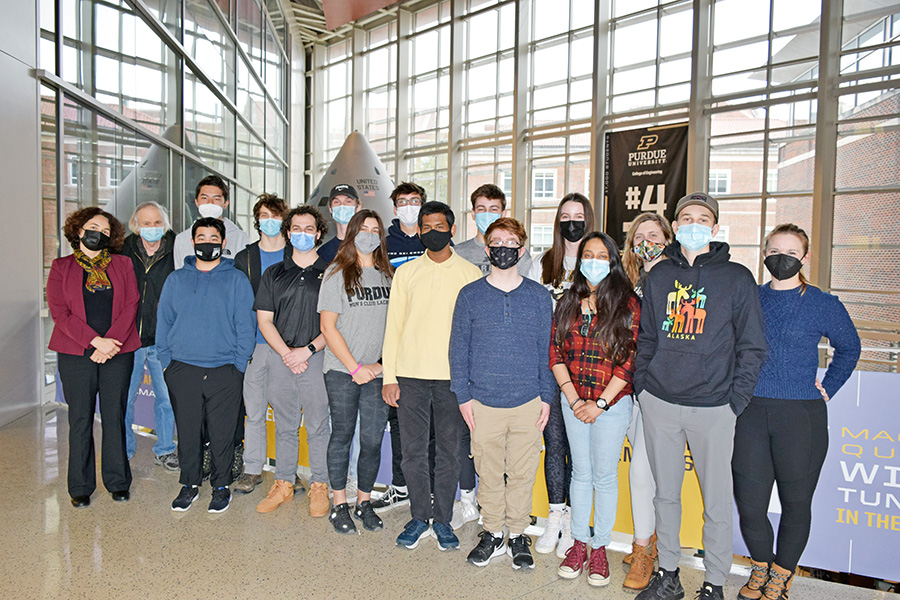Purdue Students Developing Space Camera for Studying Solar Sail Topography

Students across Purdue’s College of Engineering are contributing to the largest solar sail project ever to be deployed. Solar sails have the potential to provide a new type of propulsion, one that uses no fuel, for many types of space missions.
“Solar sails are large, mirror-like structures made of a lightweight material that reflects sunlight to propel the spacecraft,” says Les Johnson, principal investigator for the NASA Solar Cruiser. “The continuous solar photon pressure provides thrust with no need for the heavy, expendable propellants used by conventional chemical and electric propulsion systems.”
Johnson says the Solar Cruiser mission will have a sail approximately 51 times larger than LightSail 2 – itself an active mission that also saw Purdue contributions and launched into Earth’s orbit in 2019.
Solar Cruiser will carry a four-section sail with a total surface area of 1,653 square meters, or about a quarter the size of a FIFA-sanctioned international soccer field. That immense size and its role as a deep-space spacecraft differentiates it from prior, smaller solar sails that have remained closer to Earth.

“The Solar Cruiser’s propulsive performance will enable future science missions that can study the sun from novel vantage points that cannot be reached by any other spacecraft propulsion system,” Johnson says.
Purdue Professor Alina Alexeenko says that once launched in early 2025, the spacecraft will head to the “libration point” between the Sun and the Earth. That’s the distance where the gravity between the two bodies is equal. The propulsive sail will help it adjust its trajectory so it can remain in that relative position.
This mission will demonstrate and provide data on how a solar sail can work to navigate a spacecraft outside of Earth’s orbit, among other goals, marking a path for developing future solar sails.
Future sail-equipped spacecraft can provide increased notice of solar storms, which would give satellite operators as well as space explorers more time to take precautions against damage, Johnson says. “A Solar Cruiser solar sail could increase the warning times of solar storms by up to 50%.”

Though it’s massive in surface area, the sail sheet itself is just 2.5 microns thick — less than the diameter of a human hair. The sail’s deployment, as well as its behavior during use, will need to be monitored closely in order to understand how the material will perform in future missions. That’s where Purdue’s Solar Sail Vertically Integrated Projects (VIP) Program is providing its important contributions.
“Purdue has a student team that is looking at the camera that is going to be used to do topographical analysis of the sail while it's being used by the spacecraft,” says Kate Fowee Gasaway, a graduate mentor and instructor for this VIP course. “There might be some changes to how much it's ballooned, what its shape is, and the camera is going to be looking at that and analyzing it for the mission scientists.”
Diversity in Background and Experience is a Purdue Advantage

Purdue students from across disciplines and levels of training will be involved in this project, says Alexeenko, who is associate dean for undergraduate education in the College of Engineering, as well as a professor at the School of Aeronautics and Astronautics.
“NASA’s science mission directorate allows student collaborations … where students can design, build, test and operate space missions or instruments,” Alexeenko says. “The VIP program turned out to be an ideal platform for engaging students from diversified backgrounds and various majors, from first-year engineering students all the way to graduate students.”
Johnson says that Purdue’s reputation for academic excellence and its prior work on LightSail 2 were deciding factors on choosing the institution for a collaborator. Gasaway, who has both a bachelor’s and master’s degree from Purdue AAE and is working on her doctorate, added that the VIP program was also key.
“A really large part of why we got this grant was the college's dedication to incorporating undergrads in meaningful projects like this. NASA has cited the Vertically Integrated Projects program as a reason why we were able to receive this opportunity.”

Approximately 13 to 15 students have been involved in this project each semester since the spring of 2021, totaling 40 so far, Gasaway says. One of those is Becca Reineke, a junior in AAE who wants to work in the space industry. The opportunity to get deeply involved in a NASA project was a huge draw for her — but as project manager, she’s also coordinating teams of different sizes while developing skills that matter in the workplace.
“The best thing about this course is really learning all of the grunt work that happens behind engineering processes. I didn't know how to do a trade study before I came into VIP, and that's very important when you're working in any industry, not just aerospace,” Reineke says.
To that long list of benefits, Gasaway adds one more: Bragging rights. “Not every day do you get to say, ‘I have a call with NASA later.’”
